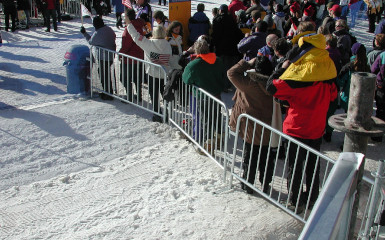Although skiing and snowboarding both boast great safety records and tend to be less dangerous than similar high-intensity sports, this is largely due to precautions taken by those who enjoy these activities. Snowboarding and skiing are challenging activities that can only be mastered through hours of hard work.
Even for the most skilled skiers and snowboarders, the sport does involve some inherent risks. The National Ski Areas Association (NSAA) reports that, on average, 41.5 people die skiing or snowboarding each year and 44.7 people sustain serious injuries. However, these activities are much safer now than they were decades ago. Many resorts have spent a tremendous amount of time and energy installing programs that educate visitors. Many of the programs and campaigns are targeted at children and beginners to ensure they are learning good safety habits from the start.
While all of these measures have helped improve safety for skiers and snowboarders, resorts cannot always depend on visitors to do the right thing. Safety measures must be enforced wherever possible, whether at the ski lifts, on the slopes, or elsewhere. One of the best ways to ensure skiers and snowboarders remain safe is to use a combination of steel barriers and proper signage to prevent access to dangerous or restricted areas.
The Benefits of Steel Barriers
The best way to ensure that skiers and snowboarders don’t go where they shouldn’t is to install steel barriers to restrict access to dangerous areas. Males in their late teens to late thirties make up a large majority of skiing and snowboarding deaths – the same demographic that suffers the most unintentional deaths from injury in general. These deaths typically result from riskier behavior, but resorts can work to discourage these visitors from taking risks in the first place.
Restricted sections that are blocked by cones, signs, or tape alone do not do much to actually prevent entry. While most skiers and snowboarders will turn around at the sight of these warnings, some might not be dissuaded. An actual steel barrier that blocks easy entry is another layer of security that should keep visitors out of closed slopes and other dangerous areas of the mountain.
Steel barriers are durable, but also lightweight enough to be transported and stored by resort employees. They typically come with hooks that create positive interlocks, allowing you to make a longer barrier that will not become disengaged. In addition, companies that make steel barriers utilize hot dip galvanization to prevent corrosion and ensure they last in all weather conditions.
How Proper Signage Helps Enforce Safety
While steel barriers do most of the heavy lifting in ensuring skiers and snowboarders don’t intentionally or accidentally enter restricted areas, proper signage is also essential to adequately communicating potential dangers. Ski resorts already rely on standardized trail markers that utilize bright colors to indicate the difficulty and status of slopes. Accidents tend to occur more often when skiers are moving very fast or the slopes are more crowded. Utilizing large, bright, and clearly visible signs can go a long way toward improving safety.
Barricade covers offer ski resorts a simple way to combine the efforts of steel barriers and signage. These covers make it much easier for skiers and snowboarders to see barriers, and they also provide a large and colorful canvas on which messages can be relayed. Many barrier covers are one bright, solid color and are used in conjunction with hook and loop signs.
Hook and loop signs are very popular because they make it very simple to attach and change messages displayed on barriers. For example, directional signs that point visitors in the proper direction can be changed with the opening or closing of a certain trail. When it comes to safety, it is vital to be able to quickly update signs so guests are informed as soon as possible.
Skier and snowboarder safety has greatly improved over the years, but it can still be an issue today if resorts don’t do their due diligence. The last thing a resort needs is a visitor to file a lawsuit over an injury. Properly blocking restricted areas and utilizing informative and noticeable signage will ensure that your resort is not held liable for any injuries that occur. Steel barriers can also be used elsewhere at a resort, like to form queues at the ski lifts or for crowd control at events. Regardless of how they are utilized, steel barriers are a must-have item for resorts.

